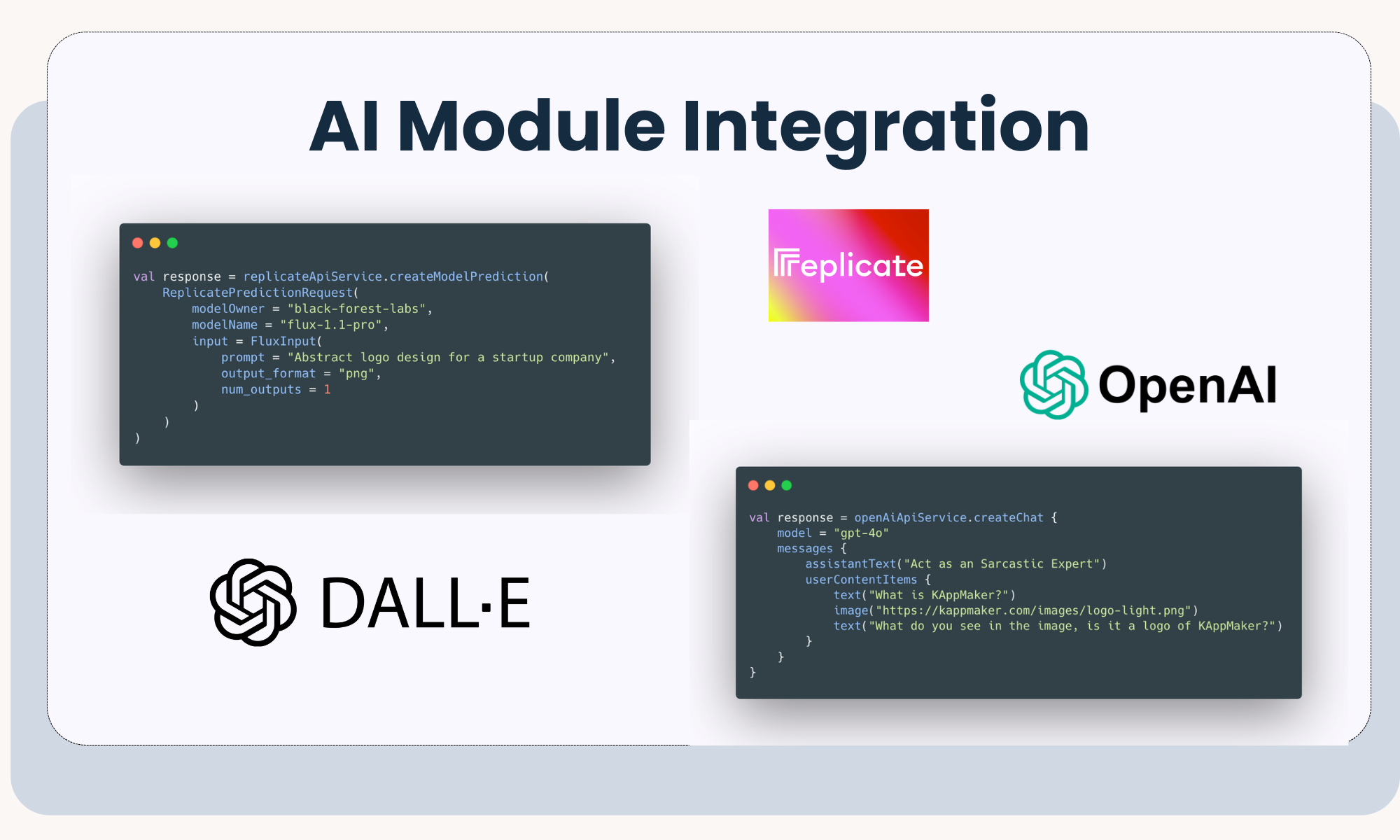AI Integration
Serverless backend built with Firebase Cloud Functions, for AI integrations like ChatGPT and Replicate AI. The AI Module in KAppMaker is ready to use with minimal setup. AI integration consists of two parts: the mobile (client) side and the backend side. We cannot directly use OpenAI or Replicate APIs on the mobile side because they require an API key, and storing API keys in client-side code is not secure. Therefore, we will add an API proxy using Firebase. Add your OpenAI or Replicate AI API keys to Google Secret Manager, deploy Firebase Cloud Functions, and set your CLOUD_FUNCTIONS_URL in util/Constants file. Firebase Cloud Functions are free to start with generous free limits, but be sure to set a budget limit to avoid unexpected charges.
You can also watch the video for AI Integration setup: https://www.youtube.com/watch?v=pdDnzjz19w8
Backend - Firebase Functions Setup
Before starting, you need to initialize Firebase in your project. First download KAppMaker-Web repo, and navigate into root folder. functions/:
1. Install Firebase CLI
If not already installed:
npm install -g firebase-tools
2. Login to Firebase
firebase login
AI Backend functions setup
1. Initialize Firebase Functions
Set up Firebase Functions:
firebase init functions
- Choose your Firebase project or create a new one.
- When prompted:
- Select
JavaScriptas the language for functions. - Install dependencies when asked.
- Select
2. Test Locally
You can test your app locally before deploying it:
firebase emulators:start --only functions
3. Deployment
firebase deploy --only functions
After Deploy it you can see your CLOUD_FUNCTIONS_URL in terminal. You will need this URL.
Configuration
The AI backend functions are pre-configured to support integration with popular APIs like Replicate and OpenAI. By default, all available functions are enabled and are implemented in the functions/index.js file. You can easily disable or customize any function by modifying this file.
Available AI Functions
-
Replicate API Functions: These functions handle interactions with the Replicate API.
replicateCreatePredictionreplicateCreateModelPredictionreplicateGetPredictionStatusreplicateCancelPrediction
You can find these functions in the
api/replicate.jsfile. Replicate API documentation for request and response: https://replicate.com/docs/topics/predictions -
OpenAI API Functions: These functions interact with the OpenAI API for generating text and images.
openAiCreateTextCompletionopenAiCreateImage
These are located in the
api/openai.jsfile. OpenAI API documentation for request and response: https://platform.openai.com/docs/api-reference/chat
API Key Management
To securely store and access your API keys, you can use Google Cloud Secret Manager. This is a secure and scalable way to manage sensitive information like API keys. Below are the steps to retrieve and store your keys securely.
Steps to Obtain API Keys
-
OpenAI API Key:
- To use OpenAI’s API, you need an API key. You can obtain it by signing up for OpenAI at OpenAI's API page.
- After signing in, go to the API Keys section under your account settings to create and retrieve your API key.
-
Replicate API Key:
- To use Replicate's API, create an account on Replicate.
- Once logged in, go to the API section of your account dashboard, where you can generate and retrieve your API key.
Saving API Keys with Google Cloud Secret Manager
Once you have your API keys, you can securely store them in Google Cloud Secret Manager.
-
Enable Secret Manager:
- In the Google Cloud Console, go to the Secret Manager page and enable the API.
-
Create Secrets:
- Click Create Secret and enter the name for the secret (e.g.,
OPENAI_API_KEYorREPLICATE_API_KEY). - Paste your API key in the Secret Value field and click Create.
- Click Create Secret and enter the name for the secret (e.g.,
-
Grant Access:
- Ensure that the service account running your application has access to the secret. You can grant access by setting the appropriate permissions to allow your app to retrieve secrets.
Disabling Functions
If you don't need any of the API endpoints, simply comment out the respective line in the functions/index.js file:
// Replicate API Function exports
exports.replicateCreatePrediction = replicateFunctions.createPrediction;
exports.replicateCreateModelPrediction = replicateFunctions.createModelPrediction;
exports.replicateGetPredictionStatus = replicateFunctions.getPredictionStatus;
exports.replicateCancelPrediction = replicateFunctions.cancelPrediction;
// OpenAI API Function exports
exports.openAiCreateTextCompletion = openAiFunctions.createTextCompletion;
exports.openAiCreateImage = openAiFunctions.createImage;
API Response Structure
All API responses are returned in JSON format. The structure follows this format:
{
"statusCode": <statusCode>,
"errorMessage": <errorMessage>,
"data": <data>
}
statusCode: Represents the HTTP status code of the response.errorMessage: If an error occurs, this field contains the error message. If there’s no error, this field will be empty ornull.data: This field contains the actual response data returned by the AI API, such as predictions, results, or generated content based on each AI api's response object.
Validation
By default, all API requests require user authentication via Firebase, primarily to secure access to the AI APIs due to their potential cost. Before making any API request, the user must be authenticated. If you want to allow unauthenticated access to any endpoint (e.g., for testing or development purposes), you can disable authentication by setting requireAuth: false in the validation function:
createPrediction: onRequest(async (req, res) => {
cors(req, res, async () => {
if (!await Validation.validateAll(req, res, { requireAuth: false })) return; <--- IN THIS LINE WE SET AUTH REQUIREMENT FALSE
await makeApiRequest(`${REPLICATE_API_BASE_URL}/predictions`, "post", getReplicateApiKey(), req.body, res);
});
}),
Mobile - Client Side Setup
Add CLOUD_FUNCTIONS_URL into util/Constants.kt file.
/**
* CLOUD_FUNCTIONS_URL should be something like: "https://REGION-PROJECT_ID.cloudfunctions.net"
* Regions:
* US(Default): us-central1
* EU: europe-west1
*/
const val CLOUD_FUNCTIONS_URL=""
Now you can use ReplicateApiService or OpenAiApiService anywhere you need.
